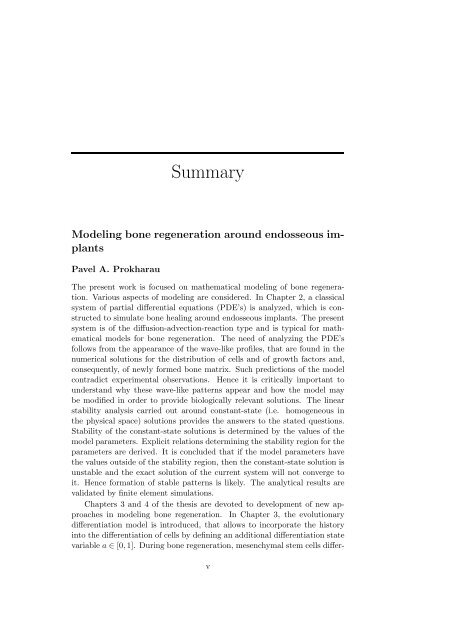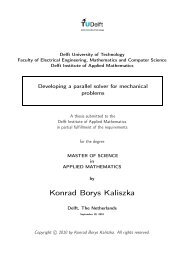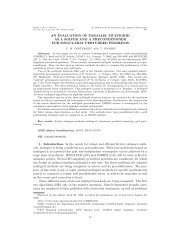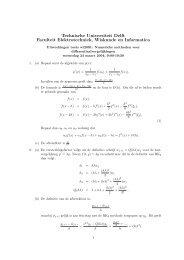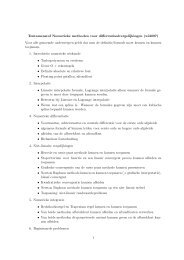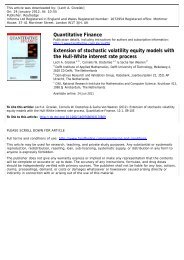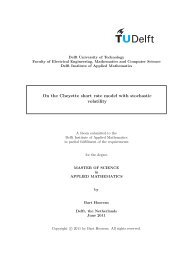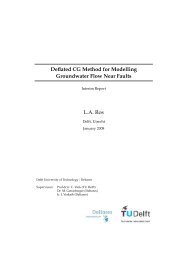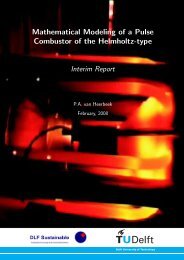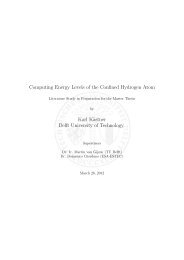- Page 1 and 2: Modeling bone regeneration around e
- Page 3: to my parents, Masha and Paulinka
- Page 7: Summaryviiis not changed within thi
- Page 10: xSamenvattingis om de voorgeschiede
- Page 14 and 15: xivCONTENTS3.3 Peri-implant osseoin
- Page 17 and 18: CHAPTER 1Introduction1.1 Bone regen
- Page 19 and 20: 1.2. Study motivation 3given by Aud
- Page 21 and 22: 1.3. Review of mathematical models
- Page 23 and 24: 1.3. Review of mathematical models
- Page 25 and 26: 1.4. Structure and subjects of the
- Page 27 and 28: 1.4. Structure and subjects of the
- Page 30 and 31: 14 Chapter 2. Linear stability anal
- Page 32: 16 Chapter 2. Linear stability anal
- Page 36 and 37: 20 Chapter 2. Linear stability anal
- Page 38 and 39: 22 Chapter 2. Linear stability anal
- Page 40 and 41: 24 Chapter 2. Linear stability anal
- Page 42 and 43: 26 Chapter 2. Linear stability anal
- Page 44 and 45: 28 Chapter 2. Linear stability anal
- Page 46 and 47: 30 Chapter 2. Linear stability anal
- Page 48 and 49: 32 Chapter 2. Linear stability anal
- Page 50 and 51: 34 Chapter 2. Linear stability anal
- Page 52 and 53: 36 Chapter 2. Linear stability anal
- Page 54 and 55:
38 Chapter 2. Linear stability anal
- Page 56 and 57:
40 Chapter 2. Linear stability anal
- Page 58 and 59:
42 Chapter 2. Linear stability anal
- Page 60 and 61:
44 Chapter 2. Linear stability anal
- Page 63 and 64:
CHAPTER 3Evolutionary cell differen
- Page 65 and 66:
3.2. Differentiation model 493.2 Di
- Page 67 and 68:
3.2. Differentiation model 51chondr
- Page 69 and 70:
3.2. Differentiation model 53If the
- Page 71 and 72:
3.3. Peri-implant osseointegration
- Page 73 and 74:
3.3. Peri-implant osseointegration
- Page 75 and 76:
3.3. Peri-implant osseointegration
- Page 77 and 78:
3.3. Peri-implant osseointegration
- Page 79 and 80:
3.3. Peri-implant osseointegration
- Page 81 and 82:
3.4. Numerical simulations 658z, mm
- Page 83 and 84:
3.4. Numerical simulations 67tions
- Page 85:
3.4. Numerical simulations 69ments
- Page 88 and 89:
72 Chapter 3. Evolutionary cell dif
- Page 90 and 91:
74 Chapter 3. Evolutionary cell dif
- Page 92 and 93:
76 Chapter 3. Evolutionary cell dif
- Page 94 and 95:
78 Chapter 3. Evolutionary cell dif
- Page 96 and 97:
80 Chapter 4. Moving boundary model
- Page 98 and 99:
82 Chapter 4. Moving boundary model
- Page 100 and 101:
84 Chapter 4. Moving boundary model
- Page 102 and 103:
86 Chapter 4. Moving boundary model
- Page 104 and 105:
88 Chapter 4. Moving boundary model
- Page 106 and 107:
90 Chapter 4. Moving boundary model
- Page 108 and 109:
92 Chapter 4. Moving boundary model
- Page 110 and 111:
94 Chapter 4. Moving boundary model
- Page 112 and 113:
96 Chapter 4. Moving boundary model
- Page 114 and 115:
98 Chapter 4. Moving boundary model
- Page 116 and 117:
100 Chapter 4. Moving boundary mode
- Page 118 and 119:
102 Chapter 4. Moving boundary mode
- Page 120 and 121:
104 Chapter 4. Moving boundary mode
- Page 122 and 123:
106 Chapter 4. Moving boundary mode
- Page 124 and 125:
108 Chapter 4. Moving boundary mode
- Page 126 and 127:
110 Chapter 4. Moving boundary mode
- Page 128 and 129:
112 Chapter 4. Moving boundary mode
- Page 130 and 131:
114 Chapter 4. Moving boundary mode
- Page 132 and 133:
116 Chapter 4. Moving boundary mode
- Page 134 and 135:
118 Chapter 4. Moving boundary mode
- Page 136 and 137:
120 Chapter 4. Moving boundary mode
- Page 138 and 139:
122 Chapter 4. Moving boundary mode
- Page 140 and 141:
124 Chapter 4. Moving boundary mode
- Page 142 and 143:
126 Chapter 4. Moving boundary mode
- Page 144 and 145:
128 Chapter 4. Moving boundary mode
- Page 147 and 148:
CHAPTER 5Numerical algorithm5.1 Int
- Page 149 and 150:
5.2. Mathematical model 133where c
- Page 151 and 152:
5.3. Numerical method 135The first
- Page 153 and 154:
5.3. Numerical method 137I a , l =
- Page 155 and 156:
5.3. Numerical method 139DCDHCcutce
- Page 157 and 158:
5.3. Numerical method 141divergence
- Page 159 and 160:
5.3. Numerical method 143following
- Page 161 and 162:
5.3. Numerical method 1455.3.5 Adve
- Page 163 and 164:
5.3. Numerical method 147where the
- Page 165 and 166:
5.3. Numerical method 149where the
- Page 167 and 168:
5.3. Numerical method 151the functi
- Page 169 and 170:
5.3. Numerical method 153where zcj,
- Page 171 and 172:
5.3. Numerical method 155The partia
- Page 173 and 174:
5.3. Numerical method 157∂C i∂z
- Page 175 and 176:
5.3. Numerical method 159present sy
- Page 177 and 178:
5.3. Numerical method 161Hence the
- Page 179 and 180:
5.3. Numerical method 163(5.74), (5
- Page 181 and 182:
5.3. Numerical method 165For the pr
- Page 183 and 184:
5.3. Numerical method 167Let us con
- Page 185 and 186:
5.3. Numerical method 169wave betwe
- Page 187 and 188:
5.3. Numerical method 1710−0.05f
- Page 189 and 190:
5.3. Numerical method 173At these s
- Page 191 and 192:
5.3. Numerical method 175Large nega
- Page 193 and 194:
5.3. Numerical method 177which is d
- Page 195 and 196:
5.3. Numerical method 179If there a
- Page 197 and 198:
5.3. Numerical method 181by inequal
- Page 199 and 200:
5.4. Discussion and conclusions 183
- Page 201 and 202:
CHAPTER 6Conclusions and outlook6.1
- Page 203 and 204:
6.2. Recommendations 187For a valid
- Page 205 and 206:
APPENDIX ANotes to the moving bound
- Page 207 and 208:
A.2. Fluxes at the moving boundary
- Page 209 and 210:
APPENDIX BNotes to the numerical al
- Page 211 and 212:
B.2. Number of adjacent cells 195(s
- Page 213 and 214:
AcknowledgmentAt the end of my four
- Page 215:
Curriculum vitae• September 2008
- Page 218 and 219:
202 BIBLIOGRAPHY[9] A. Andreykiv, F
- Page 220 and 221:
204 BIBLIOGRAPHY[32] M. Franchi, M.
- Page 222 and 223:
206 BIBLIOGRAPHY[53] H. Isaksson, C
- Page 224 and 225:
208 BIBLIOGRAPHY[76] A. Praemer, S.
- Page 227:
List of publications• P. Prokhara


